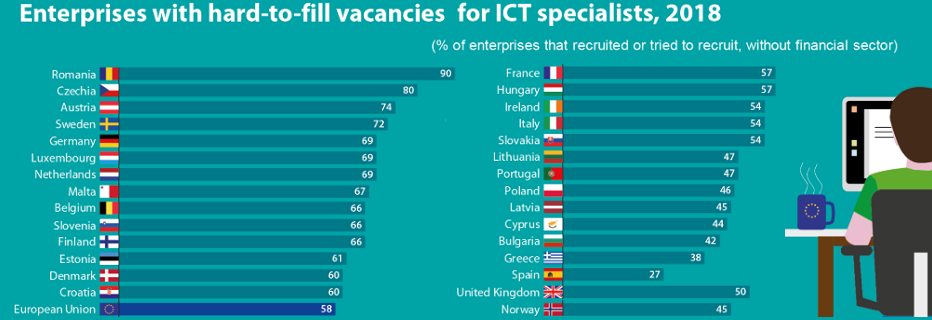COVID-19 crisis creates even greater focus on online
Until recently, it was possible to run a company where the online offering was seen as a nice-to-have, but not a non-negotiable. COVID-19 changed all that. Companies that didn’t consider online a priority are now not just at risk of missing the boat; they are missing the plane, train and automobile every single day. To stay ahead in this social distance society, you need innovative software and online services to support your customers efficiently and effectively. But that’s easier said than done…
As governments pleaded with us to stay at home as much as possible, whole industries went into deep freeze. Hairdressers laid down their scissors, the most democratic supermarkets set up velvet ropes and bouncers around the entrance, and life began to take place at two arms’ length. As a result, even those who prefer brick and mortar stores – especially the 16% of consumers known as Laggards on the far right of the technology adoption curve – found themselves searching for services and products online more often. After all, what’s the point of priority access to shops if it’s an extra risk?
Brick and mortar businesses that once relied on footfall and local word of mouth face a leap into the e-commerce unknown. They may have been running an Instagram account to bring people through the doors, but how on earth do you start developing innovative online services if your current infrastructure only slows things down? And how do you develop new applications if you can’t find a suitable and affordable developer on the market?
In this Blog we investigate the impact of the COVID-19 crisis on software development and identify other social and economic factors that are forcing companies to overhaul their IT. We show you the possibilities and how to get the most value out of your investment.
What does the COVID-19 crisis teach us?
A number of trends caught the eye when the world went into lockdown.
1. Online shopping is now well established
Whether following government guidelines or simply fearful of fines, people all over the world stayed obediently at home and kept the number of contact moments to a minimum. But people still want to keep moving and maintain wellbeing, and went online to buy yoga mats and dumbbells. And if you’re at home all the time, it’s only natural to order something new to brighten up your home office and buy comfortable clothing for those all-important Zoom calls. Companies with a web presence were able to respond to this changing purchasing behaviour and retain goods in the warehouse that would otherwise have gone on sale in physical stores. According to trade association Thuiswinkel.org, the COVID-19 crisis marks the definitive breakthrough of online shopping.
Entrepreneurs with rent and business rates to pay are finding it difficult to keep their heads above water, with a trip to town for some afternoon shopping and lunch on a café terrace not possible for the time being. Nevertheless, there is a lot of solidarity for the local middle class. Loyal consumers support them by persisting in buying locally or by ordering deliveries from their favourite restaurants, which now offer takeaway food. Retailers who distinguish themselves with expert advice, helpful staff and beautiful products can count on the support of local shoppers.
3. Homeworking is easier than expected
It all happened so quickly. One day we all stopped going to the office and found ourselves working at home perched at the breakfast bar, at the dining table or at a desk in the spare bedroom. Zoom and Microsoft Teams video calls replaced meetings in stuffy dimly rooms. Chatting with colleagues suddenly happened via Slack or Skype rather than at the watercooler. All in all, it was a pretty seamless transition, and many companies reflecting on productivity have realised that online collaboration could be a keeper. Why would you invest in expensive business premises with 100 fancy workplaces if more than half of your employees prefer to work from home on a regular basis? Why opt for expensive, in-house developers when it turns out that you can collaborate just as well with remote external staff? Suddenly, project-based collaboration with remote externals or overseas freelancers has come to look easier than many companies originally thought.
4. An online focus requires investment, but budgets are limited
It’s clear that more investment is needed to better respond to consumer demand (or those of employees in the organization) with user-friendly software, optimized websites and innovative online services. Online is the proven leader in delivering value for money, but there are upfront costs to consider.
Globally, the COVID-19 crisis is causing economies to shrink, budgets are under pressure and companies are less ready to pay exorbitant amounts of money for software development teams. Still, new software is needed to make the leap to online. Therefore, companies are looking for cheaper software development alternatives, with little appetite for expensive recruiting agencies or setting up in-house development teams.
What other factors make software development so expensive and difficult?
Software development and IT projects have been causing headaches for companies for years. COVID-19 has only highlighted how important it is to no longer delay IT investments and software development. What other factors play a role in this story?
1. Shortage of affordable and highly skilled IT professionals.
Hiring expertise in information and communication technologies (ICT) is a challenge for businesses in the European Union. Figures from Eurostat show that during 2018, more than half (58%) of those EU businesses trying to fill vacancies requiring relevant ICT skills reported problems.
Among the EU Member States, enterprises in Romania found it most difficult to recruit ICT specialists. 90% of them found it hard to fill these vacancies. Recruitment of ICT specialists was challenging for enterprises also in the Czech Republic, where 80% found it hard to fill such vacancies, as well as in Austria (74%) and Sweden (72%). In contrast, the proportion of businesses finding it difficult to recruit ICT specialists was below 40% only in Spain (27%) and Greece (38%).

Source: ec.europa.eu/eurostat, 21/02/2020
2. Relocated foreign IT specialists are no longer the solution
In the search for highly educated and affordable IT talent, companies around the EU spent years looking abroad in the hope of finding affordable IT people there. Many Asian and Eastern European countries have a long-standing focus on STEM (science, technology, engineering and mathematics) education and have invested in high-quality IT training for decades. As a result, they have sufficient IT talent in these countries to help other European countries with their software development.
IT professionals from the Ukraine, India and China were brought to the EU on working visas and for years that went well. But this kind of immigration is no longer the solution from an economic point of view, and in many countries from a political one, too. Housing these employees is an expensive business and life has become just as expensive for them. These professionals are no longer willing to live and work in the EU country for a lower salary than that enjoyed by their local colleagues. Many expats also find it difficult to settle down, and after a few years many of them choose to return to work in their native country.
That’s not all. Increasingly, young IT professionals are choosing to stay in their native country. These millennials are motivated by the thought of contributing to society as well as the bottom line. Others enjoy the low cost of living and place a premium on contact with friends and family, and are therefore less and less inclined to seek happiness abroad. This is why IT vacancies in the EU tend to remain open for longer.
3. Outdated IT infrastructure is holding back innovation
Digital transformation is the key to success. Companies want to get more out of all the data they collect. After all, this gives you new insights and you can respond even better to changes in the market and customers’ needs – but only if you manage to uncover this important information.
That’s where things go wrong for many companies. After all these years, little or nothing has been done with outdated systems and IT infrastructure, which makes it extremely difficult to implement innovation. For some companies, combining data from different web applications has become an almost impossible task. Maintaining the outdated infrastructure with all kinds of quick fixes is no longer tenable in a rapidly changing world.
Many companies are looking for new ways to replace applications with modern solutions, but don’t have the knowledge to get started.
Outsourcing as a solution for your challenges
The success of certain businesses in spite of COVID-19 has taught us that it is crucial to invest more in online applications and software development. And we also know that talent from local and abroad IT market is scarce and expensive. So it’s not surprising that outsourcing is gaining in popularity, especially when it comes to innovative and specialist IT projects, such as app development or converting legacy applications to microservices. And all with an affordable price tag.
One thing is certain, the COVID-19 crisis has shown that a lot of our prejudices about online working and collaboration are unfounded. Working remotely is no obstacle at all to the success of a project, and can even be an asset. Thanks to programs such as Slack, Microsoft Teams, Zoom, WhatsApp and BlueJeans, you are always in contact with your team, regardless of their location or working hours. So why not opt for a long-term partnership with an outsourcing partner to help you develop new and smart solutions for your business? In the near future, the business world will still face a lot of challenges, but by outsourcing your software development to a reliable outsourcing partner, you’ll at least have one less worry.
Find out more
Talk to us about your IT challenges and strategy and learn how we can help you bridge social distancing and build a new approach after the lockdown is over.





